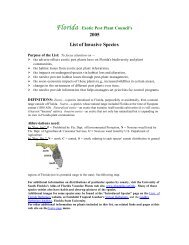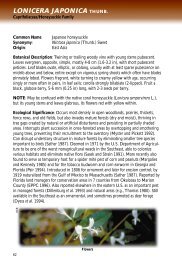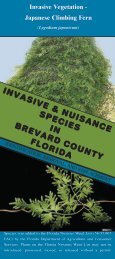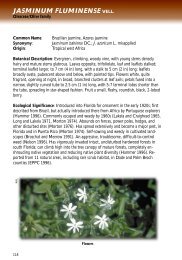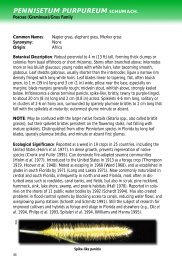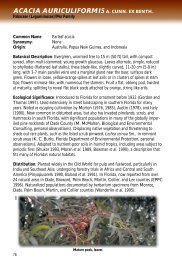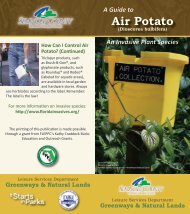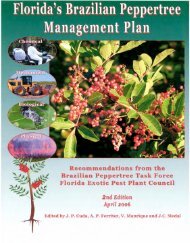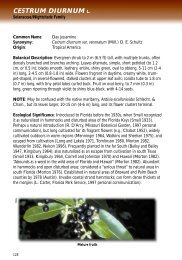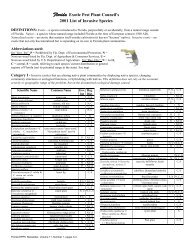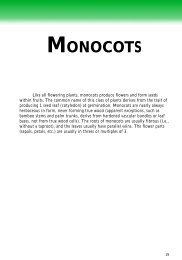DICOTS - Florida Exotic Pest Plant Council
DICOTS - Florida Exotic Pest Plant Council
DICOTS - Florida Exotic Pest Plant Council
Create successful ePaper yourself
Turn your PDF publications into a flip-book with our unique Google optimized e-Paper software.
Lonicera japonica Thunb.<br />
Caprifoliaceae/Honeysuckle Family<br />
Common Name: Japanese honeysuckle<br />
Synonymy: Nintooa japonica (Thunb.) Sweet<br />
Origin: East Asia<br />
Botanical Description: Twining or trailing woody vine with young stems pubescent.<br />
Leaves evergreen, opposite, simple, mostly 4-8 cm (1.6-3.2 in), with short pubescent<br />
petioles. Leaf blades ovate, elliptic, or oblong, usually with at least sparse pubescence on<br />
midrib above and below, entire except on vigorous spring shoots which often have blades<br />
pinnately lobed. Flowers fragrant, white turning to creamy yellow with age, occurring<br />
singly or more often in pairs, in leaf axils; corolla strongly bilabiate (2-lipped). Fruit a<br />
black, globose berry, 5-6 mm (0.25 in) long, with 2-3 seeds per berry.<br />
NOTE: May be confused with the native coral honeysuckle (Lonicera sempervirens L.),<br />
but its young stems and leaves glabrous, its flowers red with yellow within.<br />
Ecological Significance: Occurs most densely in open woodlands, prairies, thickets,<br />
fence rows, and old fields, but also invades mature forests (dry and moist), thriving in<br />
tree gaps created by natural or artificial disturbance and persisting in partially shaded<br />
areas. Interrupts plant succession in once-forested areas by overtopping and smothering<br />
young trees, preventing their recruitment to the overstory (Myster and Pickett 1992).<br />
Can disrupt understory structure in mature forests by eliminating smaller tree species<br />
important to birds (Sather 1987). Deemed in 1971 by the U.S. Department of Agriculture<br />
to be one of the worst nonagricultural weeds in the Southeast, able to colonize<br />
various habitats and eliminate native flora (Sasek and Strain 1991). More recently also<br />
found to serve as temporary host for a spider mite pest of corn and peanuts (Margolies<br />
and Kennedy 1985) and for the tobacco budworm and corn earworm in Georgia and<br />
<strong>Florida</strong> (Pair 1994). Introduced in 1806 for ornament and later for erosion control; by<br />
1919 naturalized from the Gulf of Mexico to Massachusetts (Sather 1987). Reported by<br />
<strong>Florida</strong> land managers for conservation areas in 7 counties from Okaloosa to Marion<br />
County (EPPC 1996). Also reported elsewhere in the eastern U.S. as an important pest<br />
in managed forests (Dillenburg et al. 1993) and natural areas (e.g., Thomas 1980). Still<br />
available in the Southeast as an ornamental, and sometimes promoted as deer forage<br />
(Dyess et al. 1994).<br />
KCB<br />
62<br />
Flowers



